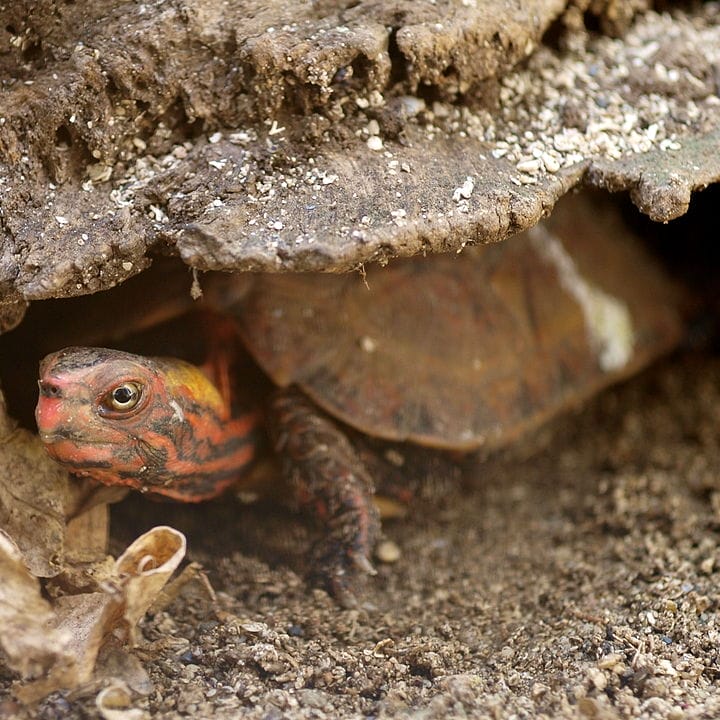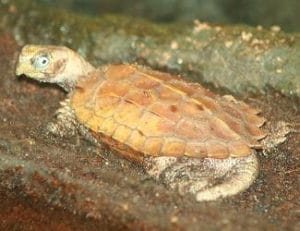Geoemyda japonica (Ryukyu Black-breasted Leaf Turtle)
Home > Turtle Database > Geoemyda japonica (Ryukyu Black-breasted Leaf Turtle)
Geoemyda japonica, commonly known as the Ryukyu Black-breasted Leaf Turtle, is a distinctive species of turtle native to the Ryukyu Islands of Japan. Renowned for its unique coloration and habitat preferences, this turtle plays a vital role in its ecosystem.
Native To These Regions
Amami Islands (Japan), Okinawa (Japan)Native Turtle Species Map – Find Turtles by Region
Scientific Classification
- Kingdom: Animalia
- Phylum: Chordata
- Class: Reptilia
- Order: Testudines
- Family: Geoemydidae
- Genus: Geoemyda
- Species: Geoemyda japonica
Common Names
- Ryukyu Black-breasted Leaf Turtle
- Japanese Leaf Turtle
- Ryukyu Leaf Turtle
This Hilarious Turtle Book Might Know Your Pet Better Than You Do
Let’s be real—most turtle care guides feel like reading a textbook written by a sleep-deprived zookeeper.
This one’s not that.
Told from the snarky point of view of a grumpy, judgmental turtle, 21 Turtle Truths You’ll Never Read in a Care Guide is packed with sarcasm, sass, and surprisingly useful insights.
And hey—you don’t have to commit to the whole thing just yet.
Grab 2 free truths from the ebook and get a taste of what your turtle really thinks about your setup, your food choices, and that weird plastic palm tree.
It’s funny, it’s honest, and if you’ve ever owned a turtle who glares at you like you’re the problem—you’ll feel seen.
Identification
Description
Geoemyda japonica is a small to medium-sized turtle, typically reaching a carapace length of 10–15 centimeters. The carapace is domed and exhibits a dark black or dark brown coloration with intricate patterns that resemble leaf veins, providing effective camouflage in their natural habitat. The plastron is usually lighter, often yellowish or cream-colored, contrasting with the dark carapace. This species has a distinct head with prominent eyes and a sharp beak-like mouth adapted for their herbivorous diet.
Sexual Dimorphism
Sexual dimorphism in Geoemyda japonica is subtle but noticeable. Males generally have longer tails and more concave plastrons compared to females, which possess broader plastrons to accommodate egg-laying. Additionally, males may exhibit more vibrant coloration on their heads and necks during the breeding season.
Check more turtles from the Geoemyda genus
Native Origin and Distribution
Geographical Range
Geoemyda japonica is endemic to the Ryukyu Archipelago in Japan, particularly inhabiting the islands of Okinawa, Amami, and other surrounding islands. Their distribution is limited to these regions, making them a species of regional significance.
Preferred Habitat
The Ryukyu Black-breasted Leaf Turtle thrives in subtropical environments, favoring forested areas near freshwater sources such as streams, ponds, and marshes. They prefer habitats with ample leaf litter and vegetation, which provide both food resources and cover from predators. These turtles are often found in areas with dense underbrush, allowing them to forage and bask safely.
Behavior
Feeding Habits
Geoemyda japonica is primarily herbivorous, feeding on a variety of plant materials including leaves, fruits, and aquatic vegetation. Occasionally, they may consume small invertebrates or carrion, supplementing their diet with protein sources when available. Their strong beak-like mouths are well-adapted for breaking down tough plant matter.
Predators
Natural predators of the Ryukyu Black-breasted Leaf Turtle include larger birds of prey, such as hawks and eagles, as well as terrestrial mammals like raccoons and wild boars. Eggs and juveniles are particularly vulnerable to predation by a wider range of animals, including snakes and small mammals.
Reproduction
Breeding Season
The breeding season for Geoemyda japonica typically occurs in the spring, coinciding with increased food availability and favorable environmental conditions. During this time, males become more territorial and actively seek out females for mating.
Reproductive Method
Reproduction in the Ryukyu Black-breasted Leaf Turtle is oviparous. Females lay clutches of 2-5 eggs in carefully selected nesting sites, usually in sandy or soft soil near water sources. The incubation period ranges from 60 to 90 days, depending on environmental temperatures. Hatchlings emerge fully formed, capable of fending for themselves shortly after birth.
Conservation
Extinction Status
Geoemyda japonica is currently classified as Endangered on the IUCN Red List due to ongoing threats that have led to a decline in its population.
Threats
The primary threats to the Ryukyu Black-breasted Leaf Turtle include habitat destruction due to urban development and agriculture, illegal collection for the pet trade, and predation by introduced species. Additionally, pollution of freshwater habitats poses significant risks to their survival.
Conservation Measures
Conservation efforts for Geoemyda japonica involve habitat protection and restoration, strict enforcement of wildlife protection laws to prevent illegal trade, and breeding programs in captivity to bolster wild populations. Public education and community involvement are also crucial in promoting the conservation of this species.
Economic Importance
While not directly significant in economic terms, the Ryukyu Black-breasted Leaf Turtle contributes to biodiversity and ecosystem health, which indirectly supports local fisheries and agriculture. Additionally, eco-tourism centered around unique and endemic species like Geoemyda japonica can provide economic benefits to the region.
Interesting Facts
- Geoemyda japonica exhibits remarkable camouflage, allowing it to blend seamlessly with fallen leaves and forest floor debris, making it difficult for predators to spot.
- This species has a slow metabolism and can survive long periods without food, an adaptation to the fluctuating availability of resources in their habitat.
- The Ryukyu Black-breasted Leaf Turtle plays a role in seed dispersal, aiding in the propagation of various plant species within their ecosystem.
- Conservation programs have successfully bred Geoemyda japonica in captivity, offering hope for the species’ recovery and continued survival in the wild.

About Author
Muntaseer Rahman started keeping pet turtles back in 2013. He also owns the largest Turtle & Tortoise Facebook community in Bangladesh. These days he is mostly active on Facebook.













